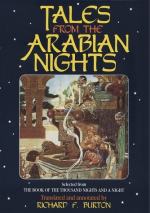[FN#99] The device has already occurred in “Ali Baba.”
[FN#100] Arab. “Al-ma’hud min ghayr wa’d.”
[FN#101] In Chavis and Cazotte the king is Harun al-Rashid and the masterfl young person proves to be Zeraida, the favourite daughter of Ja’afar Bermaki; whilst the go-between is not the young lady’s mother but Nemana, an old governess. The over-jealous husband in the Second Lady of Baghdad (vol. i. 179) is Al-Amin, son and heir of the Caliph Marun al-Rashid.
[FN#102] Vol. iii. pp. 168-179: and Scott’s “Story of the Second Lunatic,” pp. 45-51. The name is absurdly given as the youth was anything but a lunatic; but this is Arab symmetromania. The tale is virtually the same as “Women’s Wiles,” in Supplemental Nights, vol. ii. 99-107.
[FN#103] This forward movement on the part of the fair one is held to be very insulting by the modest Moslem. This incident is wanting in “Women’s Wiles.”
[FN#104] Arab. “Labbah,” usually the part of the throat where ornaments are hung or camels are stabbed.
[FN#105] The chief of the Moslem Church. For the origin of the office and its date (A.D. 1453) see vols. ix. 289, and x. 81.
[FN#106] Arab. “Satihah"=a she-Satih: this seer was a headless and neckless body, with face in breast, lacking members and lying prostrate on the ground. His fellow, “Shikk,” was a half-man, and both foretold the divine mission of Mohammed. (Ibn Khall. i. 487.)
[FN#107] Arab. “Wakt al-Zuha;” the division of time between sunrise and midday.
[FN#108] In the text “Sufrah"=the cloth: see vol. i. 178, etc.
[FN#109] Arab. “Ya Tinjir,” lit.=O Kettle.
[FN#110] Arab. “Tari,” lit.=wet, with its concomitant suggestion, soft and pleasant like desert-rain.
[FN#111] Here meaning “Haste, haste!” See vol. i. 46.
[FN#112] The chief man (Agha) of the Gypsies, the Jink of Egypt whom Turkish soldiers call Ghiovende, a race of singers and dancers; in fact professional Nautch-girls. See p. 222, “Account of the Gypsies of India,” by David MacRitchie (London, K. Paul, 1886), a most useful manual.
[FN#113] Arab. “Kurush,” plur of. “Kirsh” (pron. “Girsh"), the Egyptian piastre=one-fifth of a shilling. The word may derive from Karsh=collecting money; but it is more probably a corruption of Groschen, primarily a great or thick piece of money and secondarily a small silver coin=3 kreuzers=1 penny.
[FN#114] The purse ("Kis”) is=500 piastres (kurush)=5; and a thousand purses compose the Treasury ("Khaznah")=5,000.
[FN#115] Ms. vol. iii. pp. 179-303. It is Scott’s “Story of the Retired Sage and his Pupil, related to the Sultan by the Second Lunatic,” vi. pp. 52-67; and Gauttier’s Histoire du Sage, vi. 199-2l4. The scene is laid in Cairo.
[FN#116] Meaning that he was an orphan and had, like the well-known widow, “seen better days.”




